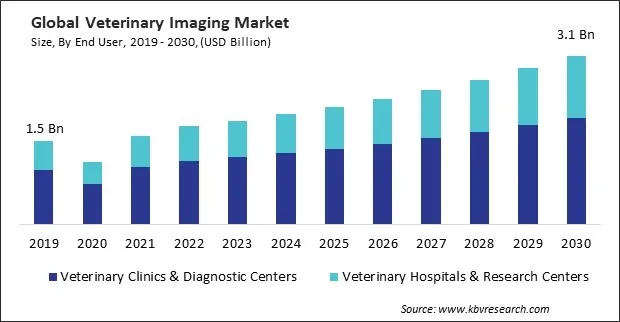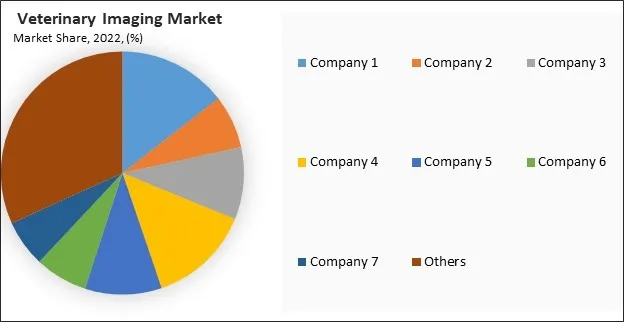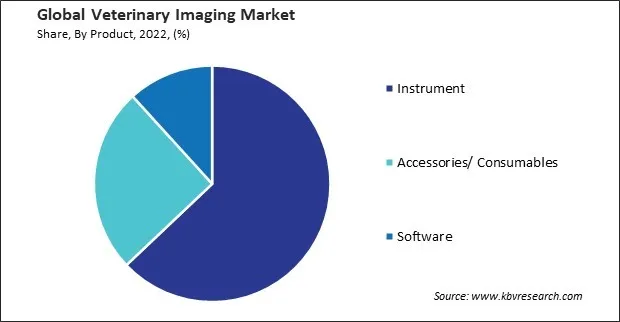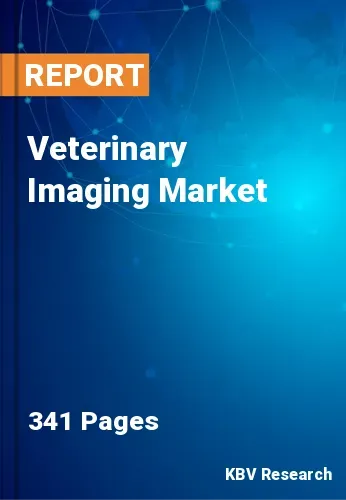“Global Veterinary Imaging Market to reach a market value of USD 3.1 Billion by 2030 growing at a CAGR of 7.1%”
The Global Veterinary Imaging Market size is expected to reach $3.1 billion by 2030, rising at a market growth of 7.1% CAGR during the forecast period.
As veterinary medicine advances, there is a growing awareness among pet owners and veterinarians regarding the importance of respiratory health in animals. Consequently, the respiratory segment would generate approximately 18.86% share of the market by 2030. This increased awareness may lead to more diagnostic imaging procedures to assess respiratory conditions. As a result, the segment will witness increased demand in the upcoming years.

As more individuals consider their pets as family members, there is a heightened awareness and emphasis on ensuring the health and well-being of these animal companions. Pet owners are increasingly willing to invest in advanced diagnostic tools and technologies to proactively monitor and address their pets' health concerns. Pet owners now have higher expectations for comprehensive healthcare services for their animals. These factors will boost the demand in the market. Moreover, one of the primary impacts is the significant improvement in diagnostic accuracy. Advanced imaging modalities, equipped with state-of-the-art technologies, provide clearer and more detailed images of animal anatomical structures and abnormalities. These factors will help in the growth of the market.
However, the substantial upfront cost of veterinary imaging equipment, such as MRI machines, CT scanners, and advanced ultrasound systems, poses a significant financial barrier for small veterinary practices. These facilities may have limited budgets, making allocating funds for expensive diagnostic equipment challenging. Smaller clinics, especially those in rural or underserved areas, may face difficulties acquiring advanced imaging technologies due to budget constraints. These factors will decrease demand for veterinary imaging in the coming years.
Furthermore, Restrictions on international trade, lockdowns, and logistical challenges affected the availability of imaging equipment and associated technologies. This led to delays in the manufacturing, delivering, and installing veterinary imaging devices. Due to economic uncertainties and financial constraints faced by veterinary practices, there was a trend of deferred purchases and equipment upgrades. Therefore, the COVID-19 pandemic moderately impacted the market.

The leading players in the market are competing with diverse innovative offerings to remain competitive in the market. The above illustration shows the percentage of revenue shared by some of the leading companies in the market. The leading players of the market are adopting various strategies in order to cater demand coming from the different industries. The key developmental strategies in the market are Acquisitions, and Partnerships & Collaborations.


On the basis of animal type, the market is divided into small animals and large animals. In 2022, the large animals segment witnessed a substantial revenue share in the market. Concerns for the health and welfare of large animals, particularly those involved in agriculture and food production, drive demand for veterinary services, diagnostics, and treatments. The practices and technology used in agriculture, including animal farming, influence the demand for veterinary services. For example, using advanced diagnostic tools for herd health management in cattle farming. Therefore, these factors will help in the growth of the segment.
Based on product, the market is segmented into instruments, accessories/ consumables, and software. The instruments segment held the largest revenue share in the market in 2022. As the number of pet owners continues to rise, there is an increased demand for veterinary services, including diagnostic imaging, to ensure the health and well-being of companion animals. There is a growing emphasis on early detection and preventive healthcare in veterinary medicine, which can drive the demand for advanced imaging instruments for accurate and timely diagnosis. These factors will boost the demand in the segments.

The instruments segment is divided into X-ray, ultrasound, CT imaging, video endoscopy, MRI, and others. The X-ray segment held the largest revenue share in the market in 2022. Advancements in imaging technology, such as digital radiography systems, have been driving growth in the market. Digital X-ray systems offer advantages over traditional film-based systems, including faster image acquisition, improved image quality, and easier storage and retrieval of images. These aspects will lead to enhanced growth in the segment.
On the basis of end user, the market is bifurcated into veterinary clinics & diagnostic centers and veterinary hospitals & research centers. In 2022, the veterinary hospitals and research centers segment witnessed a substantial revenue share in the market. Veterinary hospitals often seek advanced imaging technologies to improve diagnostic capabilities. Academic institutions, including veterinary schools and research centers, contribute significantly to the demand for veterinary imaging equipment and services. These institutions often serve as early adopters of new technologies and may engage in research projects that involve advanced imaging modalities. Therefore, these aspects will lead to increased demand in the coming years.
Based on application, the market is divided into orthopedics & traumatology, respiratory, oncology, cardiology, neurology, dental application, and others. The orthopedics and traumatology segment recorded the maximum revenue share in the market in 2022. The prevalence of orthopedic conditions and traumatic injuries in animals often drives the demand for veterinary imaging in orthopedics and traumatology. Conditions such as fractures, ligament injuries, and joint diseases may necessitate advanced imaging for accurate diagnosis and treatment planning. These factors are expected to drive the demand in the segment.
Free Valuable Insights: Global Veterinary Imaging Market size to reach USD 3.1 Billion by 2030
By region, the market is segmented into North America, Europe, Asia Pacific, and LAMEA. In 2022, the Europe segment acquired a considerable revenue share in the market. The demand for veterinary imaging in Europe is likely to be influenced by the overall size and growth of the veterinary healthcare sector in the region. An increase in pet ownership, advancements in veterinary diagnostics, and a growing emphasis on animal health and welfare may contribute to growing demand. Thus, the segment will witness enhanced growth in the coming years.
| Report Attribute | Details |
|---|---|
| Market size value in 2022 | USD 1.8 Billion |
| Market size forecast in 2030 | USD 3.1 Billion |
| Base Year | 2022 |
| Historical Period | 2019 to 2021 |
| Forecast Period | 2023 to 2030 |
| Revenue Growth Rate | CAGR of 7.1% from 2023 to 2030 |
| Number of Pages | 341 |
| Number of Tables | 580 |
| Report coverage | Market Trends, Revenue Estimation and Forecast, Segmentation Analysis, Regional and Country Breakdown, Competitive Landscape, Porter’s 5 Forces Analysis, Company Profiling, Companies Strategic Developments, SWOT Analysis, Winning Imperatives |
| Segments covered | Product, Animal Type, End User, Application, Region |
| Country scope |
|
| Companies Included | GE HealthCare Technologies, Inc., Agfa-Gevaert N.V. (IG Farben), Esaote SpA, IDEXX Laboratories, Inc., Heska Corporation (Antech Diagnostics, Inc), Siemens Healthineers AG (Siemens AG), Fujifilm Holdings Corporation, Mindray Medical International Limited, Samsung Electronics Co., Ltd. (Samsung Group), Canon, Inc. |
By Animal Type
By Product
By End User
By Application
By Geography
The Market size is projected to reach USD $3.1 billion by 2030.
Prevalence of various diseases in animals are driving the Market in coming years, however, Limited availability of veterinary imaging technologies in rural or remote areas restraints the growth of the Market.
GE HealthCare Technologies, Inc., Agfa-Gevaert N.V. (IG Farben), Esaote SpA, IDEXX Laboratories, Inc., Heska Corporation (Antech Diagnostics, Inc), Siemens Healthineers AG (Siemens AG), Fujifilm Holdings Corporation, Mindray Medical International Limited, Samsung Electronics Co., Ltd. (Samsung Group), Canon, Inc.
The expected CAGR of this Market is 7.1% from 2023 to 2030.
The Veterinary Clinics & Diagnostic Centers segment is leading the Market by End User in 2022 thereby, achieving a market value of $2 billion by 2030, growing at a CAGR of 6.8 % during the forecast period.
The North America region dominated the Market by Region in 2022 thereby, achieving a market value of $1.2 billion by 2030, growing at a CAGR of 6.5 % during the forecast period.
Our team of dedicated experts can provide you with attractive expansion opportunities for your business.

 Drivers
Drivers
 Restraints
Restraints
